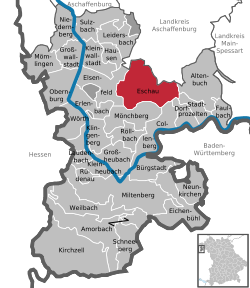Eschau
| Eschau | ||
|---|---|---|
| ||
 Eschau | ||
Location of Eschau within Miltenberg district  | ||
| Coordinates: 49°49′13″N 9°15′26″E / 49.82028°N 9.25722°ECoordinates: 49°49′13″N 9°15′26″E / 49.82028°N 9.25722°E | ||
| Country | Germany | |
| State | Bavaria | |
| Admin. region | Unterfranken | |
| District | Miltenberg | |
| Government | ||
| • Mayor | Michael Günther (SPD) | |
| Area | ||
| • Total | 38.12 km2 (14.72 sq mi) | |
| Population (2015-12-31)[1] | ||
| • Total | 3,778 | |
| • Density | 99/km2 (260/sq mi) | |
| Time zone | CET/CEST (UTC+1/+2) | |
| Postal codes | 63863 | |
| Dialling codes | 09374 | |
| Vehicle registration | MIL | |
| Website | www.eschau.de | |
Eschau is a market community in the Miltenberg district in the Regierungsbezirk of Lower Franconia (Unterfranken) in Bavaria, Germany.
Geography
Location
Eschau lies in the Bavarian Lower Main (Bayerischer Untermain) Region.
Subdivisions
The community has the following Gemarkungen (traditional rural cadastral areas): Eschau, Hobbach, Oberaulenbach, Unteraulenbach, Sommerau, Wildensee and Wildenstein.
History
Eschau was an Amt of the Lordship of Wildenstein held by the Counts of Erbach and mediatized by Prince Primate von Dalberg (Principality of Aschaffenburg/Grand Duchy of Frankfurt) in 1806, which in 1814 passed to Austria, and shortly thereafter to Bavaria.
Demographics
Within town limits, 3,395 inhabitants were counted in 1970, 3,891 in 1987 and in 2000 4,145. On 2 January 2008, another count yielded the figure 4,213.
By age, the population breaks down thus:
- 0 - 6 — 206
- 6 - 14 — 365
- 15 - 17 — 138
- 18 - 24 — 384
- 25 - 29 — 273
- 30 - 49 — 1.252
- 50 - 64 — 841
- 65 + — 754
Economy
Municipal taxes in 1999 amounted to €1,961,000 (converted), of which net business taxes amounted to €383,000.
According to official statistics, there were 8 workers on the social welfare contribution rolls working in agriculture and forestry in 1998. In producing businesses this was 332, and in trade and transport 56. In other areas, 135 workers on the social welfare contribution rolls were employed, and 1,478 such workers worked from home. There was one processing business. Eight businesses were in construction, and furthermore, in 1999, there were 63 agricultural operations with a working area of 758 ha, of which 407 ha was cropland and 345 ha was meadowland.
Government
The mayor is Michael Günther (SPD).
Community council
The council is made up of 16 council members with seats apportioned thus:
- SPD 6 seats
- CSU 4 seats
- Hobbacher Wählergemeinschaft (HWG) 3 seats
- Unabhängige Wählergemeinschaft Eschau (UWE) 3 seats
Coat of arms
The community’s arms might be described thus: Per fess embattled of one, in chief Or a pair of balances sable, in base three mullets of six, one and two, argent.
The Counts of Rieneck are known to have been in Eschau by 1232. The settlement was raised to market community in 1285. When the Counts died out in 1559, Eschau, together with the Lordship of Wildenstein passed to the Counts of Erbach, with whom it stayed until the Old Empire came to an end in 1803. The tinctures gules and Or (red and gold) are drawn from the arms once borne by the Counts of Rieneck. The mullets (star-shapes) are drawn from the arms once borne by the Counts of Erbach. The battlement-shape forming the escutcheon’s partition stands for the market community’s fortifications. As a symbol of law and justice, the balance stands for the community’s market rights.
The arms have been borne since 1962.[2]
Education
In 1999 the following institutions existed in Eschau:
- Kindergartens: 200 places with 162 children
- Primary schools: 1 with 20 teachers and 326 pupils
Notable people
The expressionist painter Fritz Schaefler (1888−1954) spent his childhood until 1900 in Eschau.
The CSU politician Berthold Rüth was born on 28 March 1958 in Hobbach, Eschau. He has been a Member of the Bavarian Landtag since 6 October 2003.
References
| Wikimedia Commons has media related to Eschau (Lower Franconia). |
